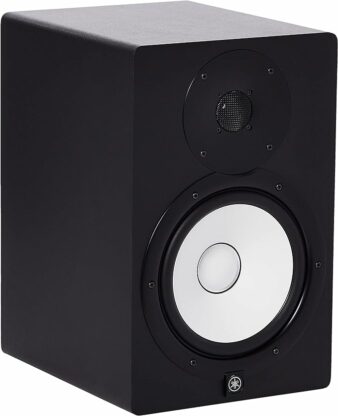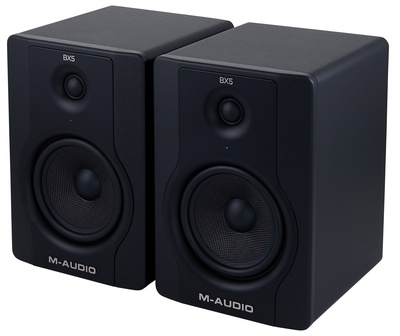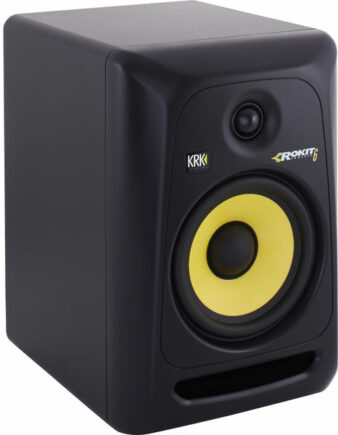So, let’s say you don’t have proper studio monitors and you want to buy a set of speakers to improve your mixes. In this article we will help you choose the best studio monitors for you, depending on your needs and budget, so you can start mixing your songs properly.
The Benefit Of Professional Studio Monitors
Many times the speakers are the last piece of equipment that we buy. I’ve seen recording studios with great microphones, several MIDI controllers, and a proper audio interface but without a good pair of monitors, and in my opinion, it should be one of the most important parts of your studio. Studio monitor speakers are quite affordable these days, and you need one for your home studio! Most of the monitors we’ll list in this post will not cost more than 500€ ($450) for a pair.
But why is having reasonably good speakers important? Well…if you can’t hear what you’re mixing, you won’t be able to correct the errors in the mix, and a bad monitor will guide you in the wrong way. Good speakers will provide accurate sound in all (or most) frequencies. Cheap equipment usually fails to reproduce the low frequencies correctly and its frequency response is less accurate.
How To Choose Your Speakers?
Well, this can be overwhelming at first, but here we have a set of questions to narrow the search:
1. What is your budget? Obviously, with more money, you’ll be able to get better equipment.
2. Which music style will you work on? Depending on the music style you may need more power (bigger woofer size) and maybe require a subwoofer.
3. What is the size of your mixing room? Small rooms do not respond well to powerful monitors unless you have very good room sound treatment.
Top 3 Affordable Home Studio Monitors
We will review 3 home studio monitors and list their characteristics, price per pair, and their pros and cons. We will only analyze nearfield active monitors in this article because we believe they are the best option for mixing purposes in home studios. If you are looking for mastering monitors, then you should consider midfield monitors.
Yamaha HS 8

The Yamaha HS 8 is an active 2-Way Nearfield Monitor. It has enough power for all music styles and works best in medium-sized rooms. Usually, you won’t need more power, and the quality is very good for the price. It features an 8″ Woofer, which is a suitable size for achieving good low-frequency response for those working on EDM. Additionally, it has XLR and TR balanced inputs. While it is pretty affordable, it is the most expensive option on this list, at 550€ for a pair.
Its main characteristics are:
- 120 W, 8″ Woofer + 1″ Tweeter.
- Frequency Range: 38 Hz – 30 kHz.
- XLR Input balanced, 1/4″ TR Input balanced.
- Room Control and High-Trim Tone Control.
- 275€ per unit.
M-Audio BX5

The M-Audio BX5 D2 is also a 2-Way active Nearfield Monitor. With 70W, it is a good option for medium and small-sized rooms. This is a great choice for those working in pop, rock, jazz, or classical styles that don’t require high precision and power in low frequencies. It has balanced XLR inputs, as well as unbalanced and TRS inputs, which is important. The price is the best part, about 225€ for the pair.
For EDM, you may want to check the M-Audio BX5 2.1 System, which includes a subwoofer.
The main characteristics of the BX5 are:
- 70W, 5″ Woofer + 1″ Tweeter.
- Frequency response: 53 Hz – 22 kHz.
- Balanced XLR and balanced/unbalanced TRS inputs.
- 225€ for the pair.
KRK RP6 RoKit G3

The KRK RP6 RoKit G3 is another 2-way active monitor, with 73W and a 6″ woofer. It is likely a midpoint between the Yamaha HS 8 and the M-Audio BX5. It offers good frequency response, a medium-sized woofer, and balanced inputs. Represents a solid choice for those in medium or small rooms who want good quality and accuracy but don’t require a lot of power.
Its main characteristics are:
- 73 W, 6″ Woofer + 1″ Tweeter.
- Frequency response: 38 Hz – 35 kHz.
- Input connectors: RCA, XLR, and 1/4″ TRS.
- 220€ per unit.
Conclusion
Any of the 3 home studio monitors will be a good choice; which one is the best for you will depend on your needs. In my opinion, if you have the budget, go for the Yamaha HS 8. If you don’t, then the M-Audio BX5 is also a good start; you can always add the subwoofer to the kit if you need it.
Sobre el autor

Dídac
CEO y Fundador de MasteringBOXDídac es un ingeniero de audio profesional, productor musical e ingeniero de software. También es el fundador de MasteringBOX y el autor de muchos de los artículos del blog.
Deja un comentario
Inicia sesión para comentar


